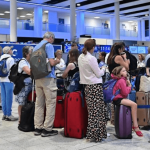
A new report published by “Unify Square” highlights breaks in stress levels among workers at different job positions and activities
A new report published by “Unify Square” highlights breaks in stress levels among workers at different job positions and activities, and how elevated adoption of collaboration and UC employment has impacted the completion of internal communication at companies. Since the coronavirus pandemic forced a large majority of the business workforce into smart work, 72% of firms rolled out at least one new job application.
Zoom reigns king with over 50% of companies joining the application to their collaboration repertory, but Microsoft Teams follows nearly behind at 43%. The review unveiled a substantial disconnection between company management and lower-level workers linked to the security of data and communications. Over 65% of employers, c-levels, and managers indicated their organization encountered security disturbances related to collaboration or information, while 83% of entry-level employees were working with blinders not thinking that their company was at risk of a collaboration misadventure.
Opposite to popular opinion, only half of businesses have achieved strengthened governance and security restriction for collaboration applications for moving their workforce to a remote form. Scott Gode, CMO, Unify SquareEven affirmed that prior to the sudden departure from traditional workspaces, enterprises across the globe were being faced with countless disruptions and concerns about governance and security, for collaboration networks.
“The need for specialized third-party programs, united with innovative professional services is more critical than ever before to help highlight blind spots, and complete and enforce policies to minimize data loss danger.” It’s no surprise that stress levels between workers have grown in the wake of the covid health emergency. Sixty-one percent of technology operators and 63% of c-level workers affirmed their stress levels have increased since working from home. While, entry-level employees are able to stay almost stress-free with only 34% confessing to handling prolonged stress.
"Stress levels of remote workers are significantly higher than those of people who work in the office. And I suspect that will start playing a part in what we’re going to experience going forward." https://t.co/t9KO1YsGrb
— John Palfrey (@jpalfrey) April 5, 2020
Possible causes of pressure include the personal difficulties that workers are experiencing while serving from home, such as missing the habit of being in the office (43%), cooperating with associates in person (41%), disturbances at home (35%), and juggling personal commitments on top of job (32%). Taking a home office up to the rules that employees are used to is a test for companies and operators alike. Over half of business workers focusing on IT or security have had to buy new tools or hardware to facilitate their task from smart setup, however, only 12% stated their organization supported or compensated for it all economically.
Even with the right tools and platforms, 42% of work employees ages 18-24 years assumed that it took about thirty days to prepare their home-based room service at the property that it did when they were in the post. Yet, 40% of those 55 and older said it served great from day one, which is a surprising observation from their tech-savvy younger peers who would be presumed to have less problem with their setup right off the turn.
Interference from darlings (48%), someone walking through the environment (33%), gardeners/contractors making sound (27%), children making surprise guest arrivals (26%), shipments making noise (26%), power interruptions (24%), noisy next-door-neighbor (21%), and cleaning co-operation vacuuming or dusting around your workspace (9%) were all seen as responsible for distractions while on a conversation call. When the home office wasn’t really doing it for them, 22% of those ages 65 and older revealed to taking interview calls from unconventional locations including the closet, in an automobile, on a ship, in a shop, from a child’s sporting competition, and even from the toilet.
Prospects of smart work productivity become a significant point of controversy among companies and their workers. Approximately half of tech operators consider that there is a higher set of criteria for productivity within their company since serving remotely.
The study revealed some gaps in attitudes around efficiency across job positions. Forty-four percent of proprietors, managers, and C-levels think collaboration with colleagues has become much more efficient since shifting to a remote system, while only 11% of senior executives admit. Yet 44% of workers said their company has not implemented any actions to help expedite collaboration in a remote context.







